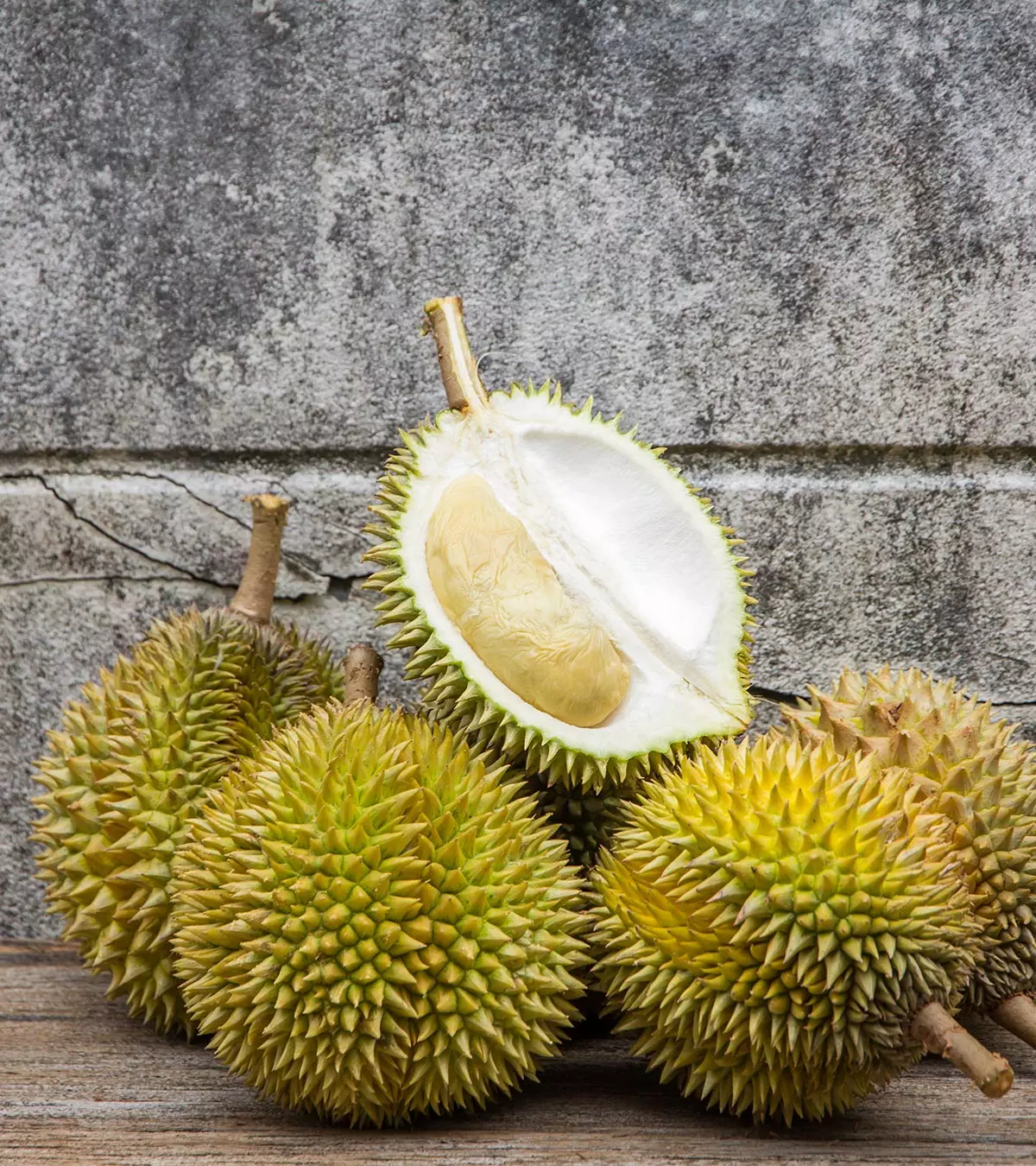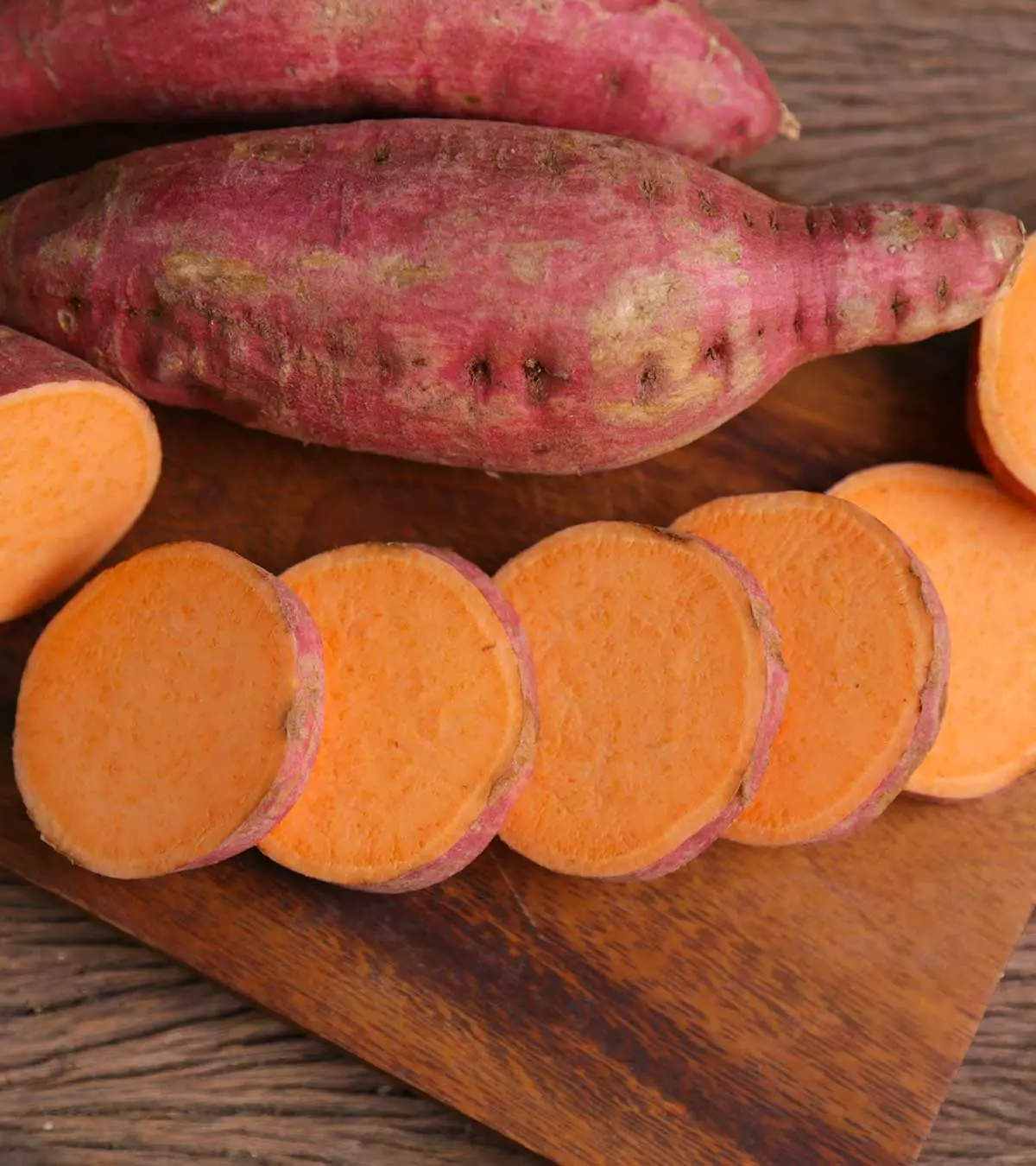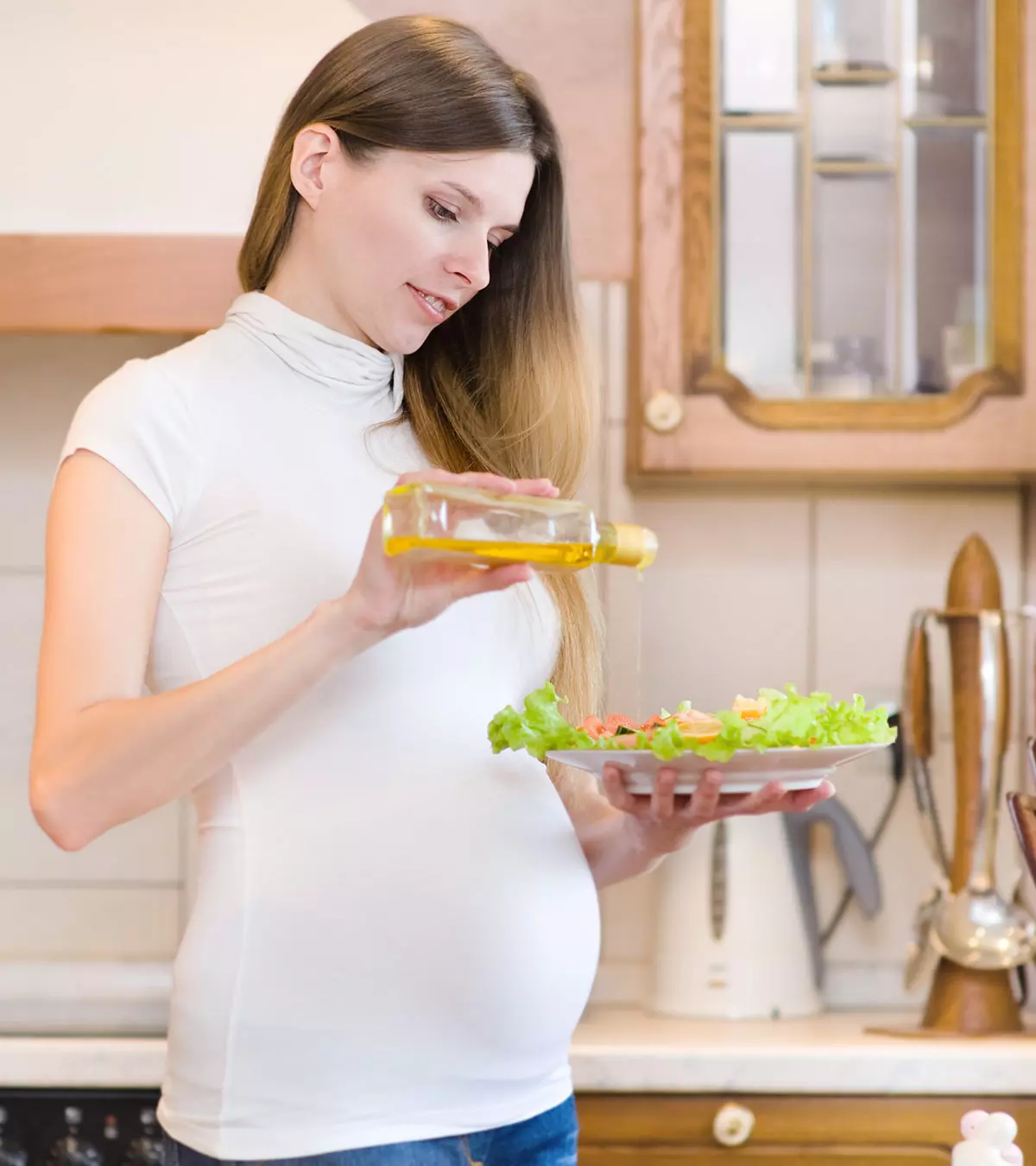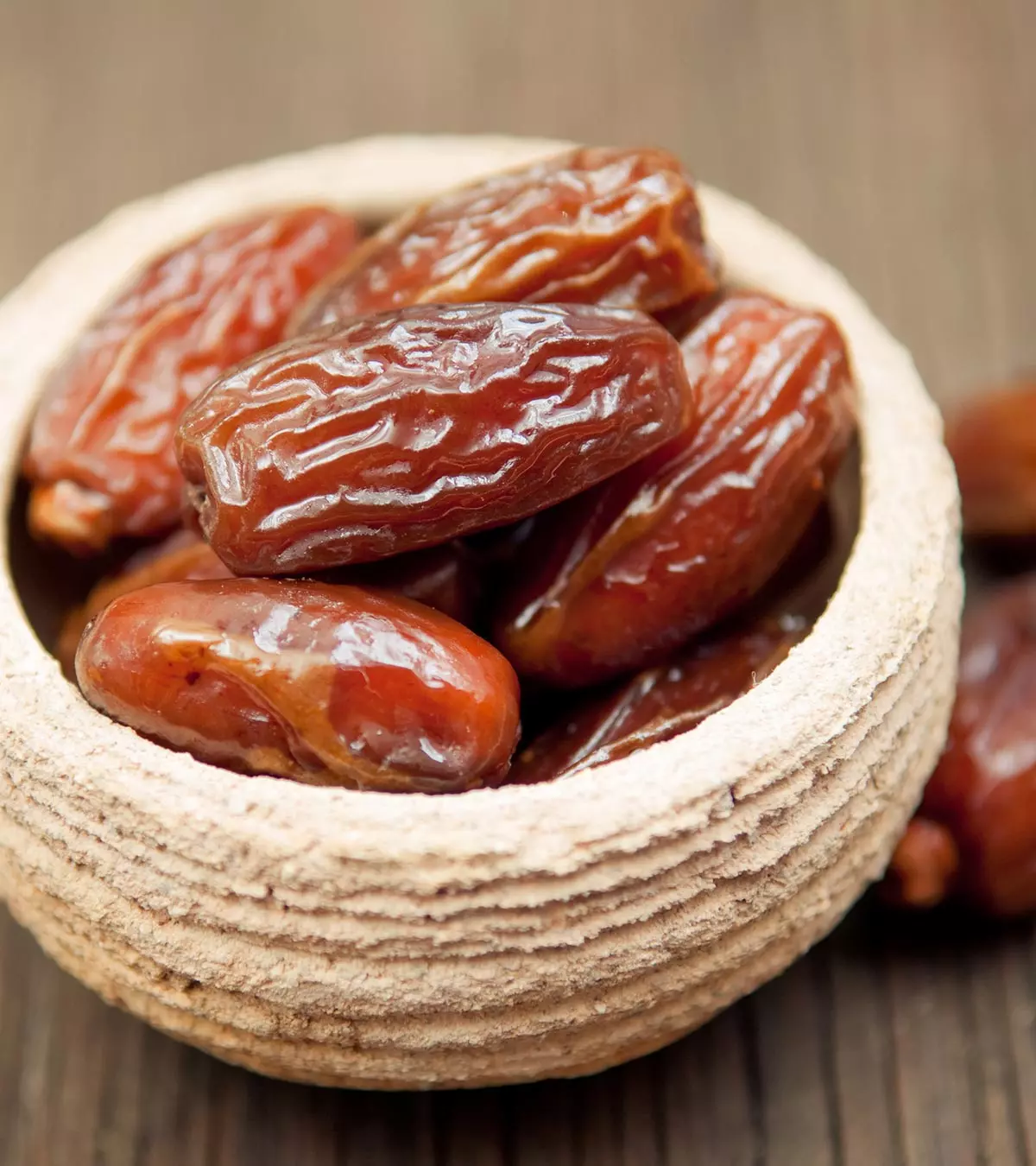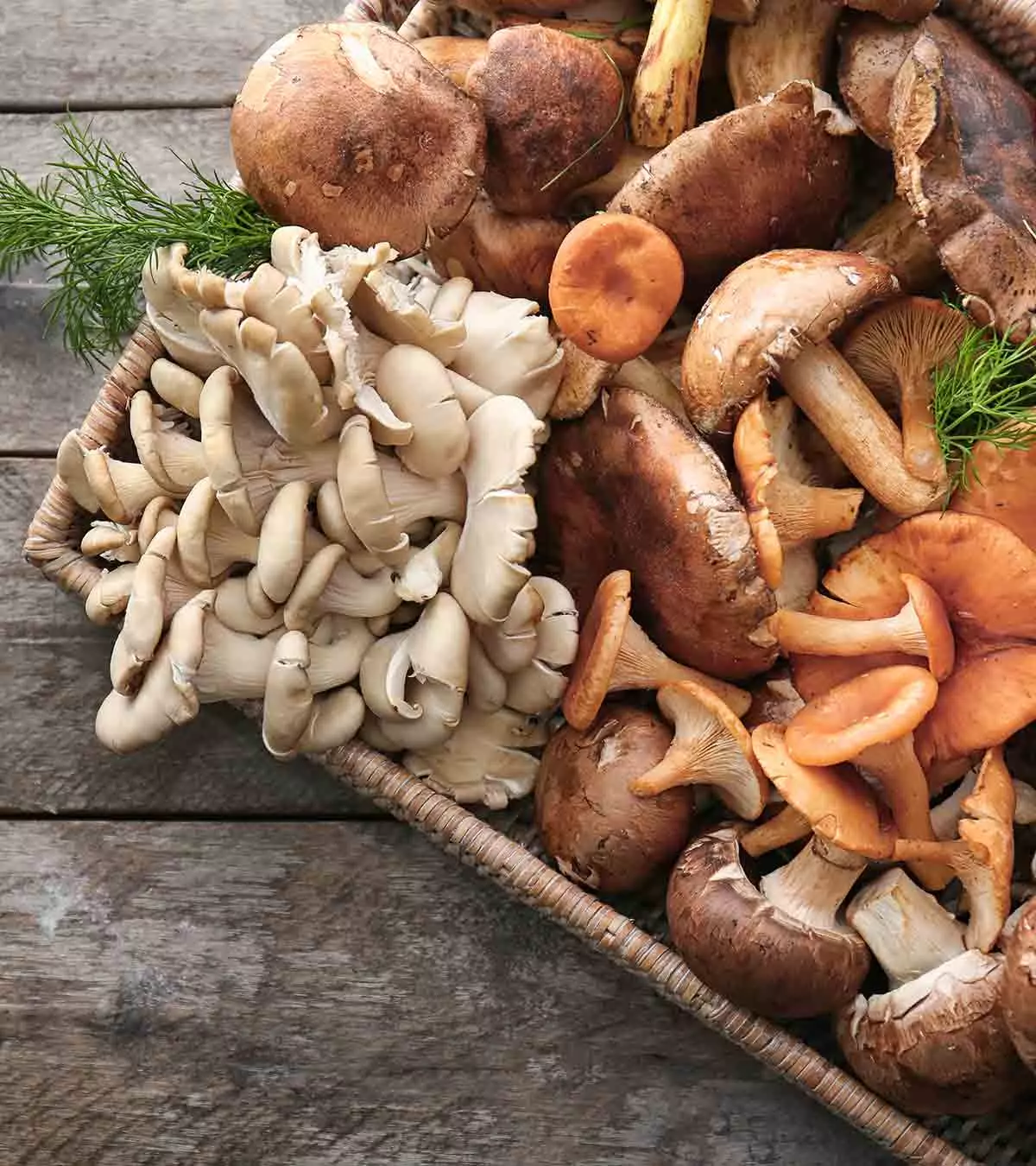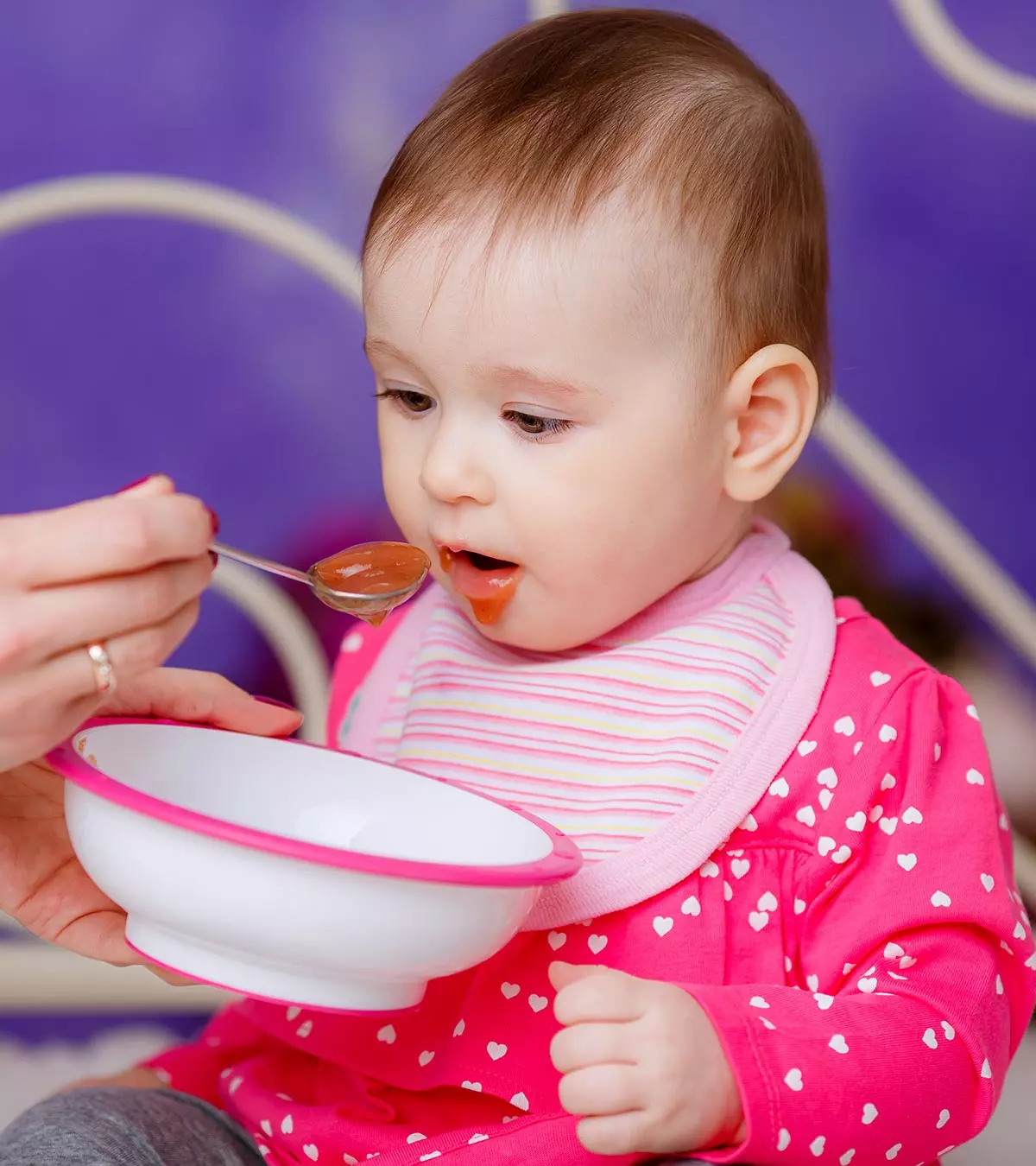
Image: ShutterStock
If your little bundle of joy has started eating solids, you may have considered including fish in their diet. However, to ensure you introduce this protein to them in an age-appropriate manner, you should find the right fish recipes for babies. Fish is known to be highly beneficial for children and adults (1). It contains high amounts of vitamin D and omega 3 fatty acids, which are important for the adequate development of your baby’s brain and eyes. They also contain high levels of proteins without saturated fat content. Moreover, fish is a rich source of vitamins such as vitamin D and vitamin B2 and minerals such as iron, zinc, calcium, fluorine, iodine, magnesium, and potassium. However, it is a well-known fact that introducing new foods to babies and children is not easy. So how should you go about it? Read on for a list of healthy, simple, quick, and delicious fish recipes that you can try making for your baby.

Key Pointers
- Fish is a rich source of proteins for babies.
- Fish is abundant in vitamin D and omega-3 fatty acids that support brain and eye development.
- Introduce fish to a child’s diet as early as six months old, unless they are allergic.
- Symptoms of a fish allergy include rash, wheezing, vomiting, swelling of the face, tongue, and lips.
- Flounder, Haddock, and Cod are some easy-to-digest and nutritious fish options for babies.
When To Include Fish In Your Baby’s Diet?

When it comes to fish, there is a cacophony of expert voices! Some say wait till your baby is one before you introduce fish while others prefer waiting till the baby turns three. Studies have shown that children in the US eat fish and shellfish less than other sources of animal proteins (2). This may be due to misconceptions related to these foods. This is because fish is a known allergen. If your baby is prone to allergies, it is better to wait till she is one. But if your baby shows no sign of allergies, you can introduce her to fish by six months of age (3)! If their initial introduction to solids goes without a hitch, you can add new flavors to their diet by introducing fish.
But if you are thinking about when can babies eat shellfish and crustaceans such as lobster, oysters, etc. do consult your baby’s pediatrician first.
 Research finds
Research findsWhat Fish To Start With?
UK-based clinical nutritionist Akanksha Kulkarni suggests, “You may introduce fish puree to babies around 6 to 8 months, provided it is properly cooked, boneless, and blended into a smooth form. Light and flaky fish such as cod, haddock, or sole are recommended. Fish puree pairs well with sweet potato or carrot, enhancing both flavor and nutritional value.
“Fish does contain mercury, which is a significant concern. High-mercury fish like swordfish and king mackerel should be avoided. Instead, choose fish like salmon, trout, or sardines, which are low in mercury. Always start with small portions to check for any allergies.”
Experts also recommend tuna because it is light on the stomach, especially for children. Salmon, trout, and herring are great choices if you are looking for low-mercury content in fish (4). If you have decided to go ahead and give your baby a taste of fish, start with “white flesh” fish types. Some safe varieties of fish suitable as first baby food are:
- Flounder
- Haddock
- Cod
All these varieties are easy to digest and healthy for your baby.
Is Your Baby Allergic To Fish?
When you introduce any new food to your baby, look out for allergy symptoms. Here are a few symptoms to watch out for (5):
- Swelling of the tongue, lips, and face
- Skin rash
- Wheezing
- Vomiting

If your baby reacts with any of these symptoms, go to your pediatrician.
Are you looking for ways on how to cook fish for baby, make sure to de-bone it completely. This is the most important part of cooking fish for baby.
Fish Recipes For Babies
There are a number of ways you can cook fish. You can poach, bake, or steam the fish. You can also add veggies and fruits to make it more delicious. Homemade fish is best for your baby’s health.
Fish is a low-fat high-quality source of protein. It is rich in omega-3 fatty acids and vitamins. Moreover, it provides several minerals such as calcium, phosphorus, iron, zinc, iodine, magnesium, and potassium. According to the American Heart Association, you must eat fish at least two times a week as a part of a healthy diet (6). But there are several recipes and varieties of fish which may confuse parents when they start off for their babies. Salmon or tuna? Fried or baked?
Okay, don’t get confused! We have come up with a few easy to make, lip smacking fish recipes packed with nutrition. Your baby will love them, for sure!
1. Mashed fish
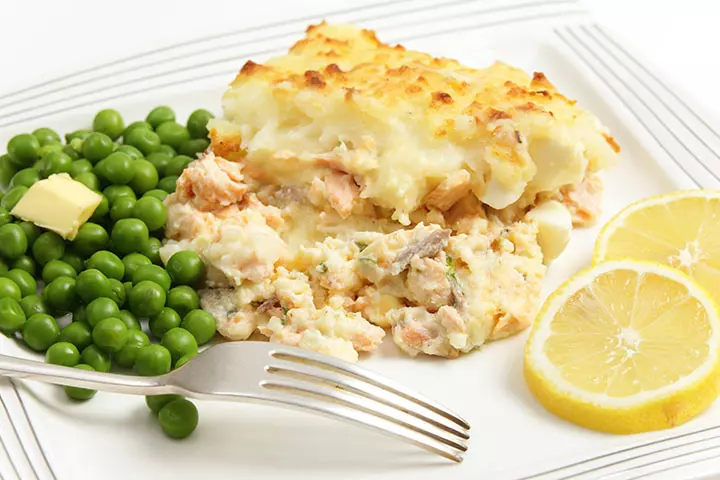
Wholesome and easy to make – this tasty fish recipe for babies is a winner!
Ingredients
- One filet of any fish
- ⅛ cup or 2% whole milk
- 1tbsp melted butter
- ½tsp salt
- ⅛ cup mashed peas
- ⅛ cup mashed carrots
- ⅛ cup mashed potatoes
How To Make
- De-bone the fish.
- Now, cook the fish by steaming, poaching or baking.
- Shred the cooked fish to pieces to ensure all bones have been removed.
- Put all the ingredients in a blender and blend or dice.
- Toss all the ingredients together and serve!
 Point to consider
Point to consider2. Fish pie
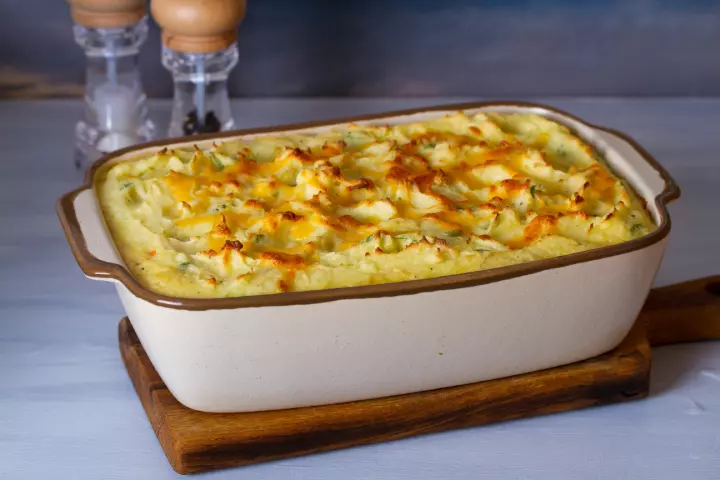
Who can refuse a pie? Prepare this easy fish pie to spread smiles.
Ingredients
- 5 medium potatoes, evenly cut into chunks
- Some butter
- 3-4tbsp milk
- 300g cod fillets, cut into large chunks
- 300g salmon fillets, cut into large chunks
- 75g baby spinach
For cheese sauce
- 30g unsalted butter
- 30g plain flour
- 400ml milk
- 90g Cheddar cheese, grated
- Pinch of grated nutmeg
- Sea salt
- Freshly ground black pepper
How To Make
- Preheat the oven to 350°F (180°C).
- Boil the potatoes for approximately 15 minutes until tender, then drain and mash with butter and milk.
- For the cheese sauce, melt butter in a medium pan, whisk in flour until smooth, and slowly add milk while stirring constantly.
- Once the sauce thickens, stir in most of the cheese, nutmeg, and season to taste.
- Gently combine fish and baby spinach with the cheese sauce, transfer to a baking dish, and top with mashed potatoes.
- Sprinkle reserved cheese on top, place on a baking tray, and bake for 35 minutes until the cheese is bubbling and golden brown.
3. Oven-baked plaice
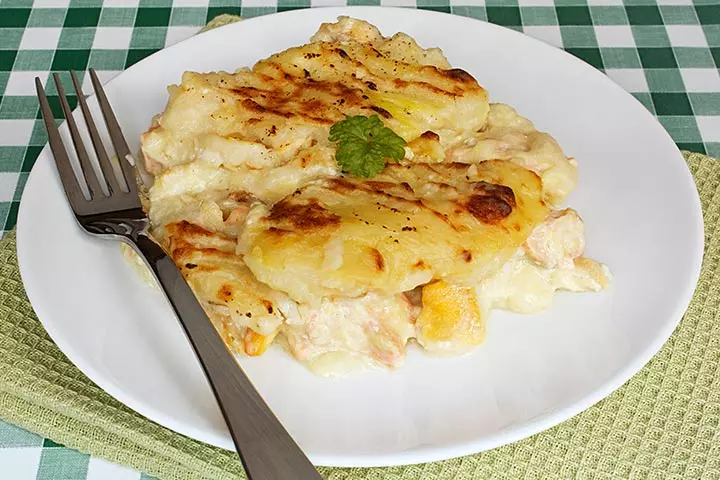
Put your oven to good use and make some yummy and flavorful fish for your little angel!
Ingredients
- One plaice filet, skinned
- 2 tomatoes
- ½tsp unsalted butter
- 4 fl oz (½ cup) milk
- One bay leaf
- 1 potato
How To Make
- Preheat oven to 350°F (180°C).
- Put plaice in an oven safe dish and place the tomato, butter and bay leaf on top.
- Pour in ¾ of the milk.
- Cover and cook for 20 minutes.
- Simultaneously, boil the potato and mash with the remaining milk and butter.
- Mash the fish and puree it along with the milk from cooking.
- Combine with the mashed potato and serve.
Alternatively, you may also try preparing fish porridge for your little one and tailor the recipe by including their favorite veggies. It is not only easy to make but also filled with nutrition. Sharing some helpful tips she follows while making fish porridge for her baby, Wendy, a mother, suggests, “To take away the fishiness, I use spring onions. It adds a lovely touch of sweetness and specks of green to the porridge. I want my children to eat spring onions. I also add sesame oil in fish porridge to mask any fishy smell (i).”
If your baby takes to fish, you are one step closer to raising a foodie! But in case of allergic reactions, stop immediately and consult your doctor. Fish can sometimes cause severe allergic reactions that can even prove fatal. Many varieties of fish are also known to contain mercury. So, stick with white flesh fish to prevent mercury poisoning.
Frequently Asked Questions
1. How should I introduce fish to my baby?
You should remember these tips while introducing fish to your baby (3):
- If your baby is exclusively breastfed, introduce fish to them only after six months
- Choose fish with low mercury content
- Check the local or state advisory before feeding your baby any fish caught locally
- Remove the bones carefully before offering fish to your baby as it may cause choking hazards
- Puree the fish meat before giving it to your baby
- Always offer well-cooked fish to your baby
2. What fish should I avoid giving my babies?
You should avoid giving your babies fish with high mercury, such as blackfin tuna, swordfish, mackerel, and shark (3).
3. Can babies eat fish every day?
Yes, babies aged six to eight months can eat fish every day as a source of protein (3).
4. How much fish can babies eat?
Infants of age six months and above can eat one to two servings of fish in a week, where one serving is equal to one ounce (3).
Parents are often concerned about introducing fish to babies due to their allergic potential. “White flesh” type fish are considered safer to start with at about eight months than shellfish. Start with small quantities of fish, such as salmon for babies, in baked, steamed, or poached forms and look out for any signs of allergic reactions such as rashes, wheezing, or vomiting. Make sure you debone the fish completely before offering it to babies. Then, you can add it to their diet in the mashed form either alone or after combining it with other vegetables. Once they are a bit older, you can offer variety in the form of finger foods too.
Infographic: Delectable Fish Snacks For Babies
Once you ensure that your baby has no allergic reactions to fish, you may prepare it in delicious ways for them. You can add vegetables to the dish to enhance its nutrient value or spices to enhance its taste. Check out the infographic below for some tasty and healthy options.
Some thing wrong with infographic shortcode. please verify shortcode syntaxPersonal Experience: Source
MomJunction articles include first-hand experiences to provide you with better insights through real-life narratives. Here are the sources of personal accounts referenced in this article.
i. Baby’s fish porridge.https://wendyinkk.blogspot.com/2010/05/baby-fish-porridge.html
References
- Advice about Eating Fish.
https://www.fda.gov/food/consumers/advice-about-eating-fish#pattern - Aaron S Bernstein et al.; (2019); Fish, Shellfish, and Children’s Health: An Assessment of Benefits, Risks, and Sustainability.
https://pmc.ncbi.nlm.nih.gov/articles/PMC6864235/ - Food for baby’s first year.
https://www.floridahealth.gov/programs-and-services/wic/nutrition-materials/_documents/food-for-babys-first-year-eng.pdf - Healthy Fish Choices for Kids.
https://www.healthychildren.org/English/safety-prevention/all-around/Pages/Protecting-Your-Children-From-Contaminated-Fish.aspx - Allergies in children.
https://www.cedars-sinai.org/health-library/diseases-and-conditions—pediatrics/a/allergies-in-children.html - Health Benefits of Fish.
https://doh.wa.gov/community-and-environment/food/fish/health-benefits - How Do I Know When My Fish Is Cooked?
https://www.seafoodnutrition.org/seafood-101/cooking/how-do-i-know-when-my-fish-is-cooked/
Community Experiences
Join the conversation and become a part of our nurturing community! Share your stories, experiences, and insights to connect with fellow parents.
Read full bio of Reda Elmardi
- Akanksha Kulkarni is a qualified clinical nutritionist with experience of more than 17 years in creating evidence-based nutrition plans for her clients. She works in England and has previously conducted workshops in Bahrain and Dubai. Akanksha had been a dietician for state and national level swimmers in India. Herself a London Fashion Week model, she has been a nutrition advisor to several models from the fashion industry.
 Akanksha Kulkarni is a qualified clinical nutritionist with experience of more than 17 years in creating evidence-based nutrition plans for her clients. She works in England and has previously conducted workshops in Bahrain and Dubai. Akanksha had been a dietician for state and national level swimmers in India. Herself a London Fashion Week model, she has been a nutrition advisor to several models from the fashion industry.
Akanksha Kulkarni is a qualified clinical nutritionist with experience of more than 17 years in creating evidence-based nutrition plans for her clients. She works in England and has previously conducted workshops in Bahrain and Dubai. Akanksha had been a dietician for state and national level swimmers in India. Herself a London Fashion Week model, she has been a nutrition advisor to several models from the fashion industry.
Read full bio of Jessica Albert
Read full bio of Swati Patwal
Read full bio of Vidya Tadapatri






